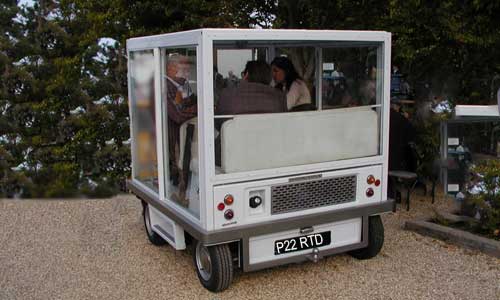The World's Strangest Cars
The biggest! The weirdest! The craziest! Etc etc etc
Click here for cheap UK car insurance!
Is it a bird? Is it a plane? Is it a conservatory?
The Quasar, this strange contraption, was the brainchild of a gentleman named Quasar Khanh, hence the unusual name for a thoroughly unusual vehicle. Mr Khanh, a Paris-based engineer from North Vietnam, had a thing about transparency which he took to extreme lengths. He designed a vehicle in which everything possible was transparent; this extended even to the seats which were inflatable and made of a transparent plastic material. The roof was also, of course, transparent which afforded almost zero protection against a hot sun. How this hothouse would have fared in the climate of North Vietnam has not been recorded; but even Europe has sufficient sunshine to ensure that the occupants would be alternatively frozen or subjected to heat exhaustion, depending upon the weather conditions of a particular day.
What shape was it?
In common with many of its near neighbours, the garden sun lounges, all corners were square. The whole design was square, actually; it was 6 feet wide and 6 feet long, hence its nickname of 'Cube'. It could carry a maximum of six passengers, ensuring it's suitability as a sauna/sweatbox during periods of sunny weather. PVC seats are not of course noted for their perspiration absorbing capabilities and so the market Mr Khanh aimed his masterpiece at was no doubt exhibitionist nudists with sadomasochistic tendencies.
Safety features
These were somewhat lacking - or more accurately, pretty well non-existent. Visibility was no doubt OK provided that the driver was not blinded by the sun. Perhaps to allow fast escape for fainting passengers the vehicle (if one may call it that) was equipped with sliding doors not only to both sides but to the front as well. Triplex safety glass was fitted (with a single, tiny windscreen wiper to clear rain, mud and dead flies); whether or not this would protect the occupants or shred their skin in the event of a collision has happily never been put to the test.
How fast was it?
With a rear mounted BMC 1.1 L engine this contraption was supposedly limited to a maximum speed of 50 mph, although it would take nerves of steel to have gone so fast in what seemed to be little more than a motorised greenhouse.
How did it handle?
With a rear mounted engine powering the back wheels, such a high centre of gravity, and small wheels of less than 11 inch diameter lifted from the BMC Mini it would probably have handled like, well, a motorised greenhouse indeed. It may be just as well that no motoring journalists saw fit to road test it.
Did it have good points?
The front and side sliding doors made it easier to get in and out of if it was parked in a tight space. It was quite manoeuvrable, provided that it didn't tip over; with quite a small turning circle. And it certainly attracted attention – mostly of the 'incredulous' variety. Oh, and it had automatic transmission as well.
Did it sell well?
What do you think? Whilst it could have made a decent Popemobile there is unfortunately only a restricted market for this type of vehicle. A French textile company ordered a few of them for their own reasons; no doubt it made sense to them at the time. Only a very small number of them were eventually built by a company called Unipower Limited which, surprisingly, no longer seems to be in existence.
